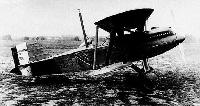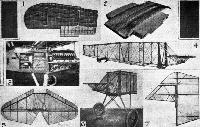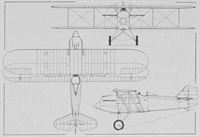Jane's Encyclopedia of Aviation
Curtiss PW-8 (USA)
Single-seat biplane fighter of 1924, 25 of which were acquired by the USAAC with 328 kW (440 hp) Curtiss D-12 engines.
Показать полностьюShow all
Flight, November 1924
THE CURTISS "P.W.8" BIPLANE
A Successful American Single-Seater Fighter
MOST of our readers will, no doubt, remember the splendid dawn-to-dusk flight from New York to. San Francisco made by Lieut. R. L. Maughan on June 23 last, when he covered the 2,670 miles in 21 hours 44 mins. The machine Maughan flew on this occasion was a standard model P.W.8 Persuit 'plane - one of an order of 25 machines built by the Curtiss Aeroplane and Motor Co., of Garden City (L.I.) for the U.S. Army Air Service. Apart from the interest attached to this machine in connection with the above flight, the P.W.8 is in itself worthy of notice inasmuch as it is claimed to be one of the most successful machines of its type amongst modern aircraft.
The P.W.8 is a development of the Curtiss racers which have, since 1922, established world's records for speed. These racers served the purpose of testing out the ideas evolved in the aerodynamic laboratories of the Curtiss Co., and when the results obtained in the various tests and racing events confirmed the theory, the new ideas involved were put into practice and were embodied in the 1924 model P.W.8 Persuit 'plane described herewith.
As may be gathered from the accompanying illustrations, the P.W.8 is a single-seater tractor biplane of the two-bay type - that is, with two sets of interplane struts each side of the fuselage. It is fitted with the Curtiss D.12 (high or low compression) engine and with wing radiators. The wings are of cellular construction, built entirely of wood, being covered with a special spruce plywood, known as Curtiss-ply. Instead of having two main spars, as in the usual type of wing, these wings have multiple spars, which, together with the ribs divide it up into a great number of square cells, forming, with the outer covering of Curtiss-ply, an extremely strong and rigid construction. The outer covering of Curtiss-ply is shaped to the correct form before it is applied, and therefore fits the wing frame like a mould. It is fastened to the framework with cement, brass screws and cement coated nails.
From the point of view of vulnerability to gun fire the advantages of this type of construction are obvious, for several cells may be shot through without impairing the strength of the structure, whilst, of course, a fabric covered wing would tear where punctured by a bullet. Apart from this, however, the cellular construction has the further advantage that it does away with internal drag bracing with its adjustments. The top plane has a fairly pronounced forward stagger of 3 ft. 1 in., and is mounted close to the top of the fuselage. Upper and lower planes are of equal span, but the chord of the lower plane is 18 ins. less than that of the top plane.
The interplane struts are of the N type, of steel tubes faired with spruce and taped. They are adjustable as to length by means of threaded terminals. There are no projecting fittings on the wing, as all these are countersunk. Aileron and engine controls are in the form of rigid rods, giving positive action and obviating the necessity of replacing cables worn out by running over pulleys, etc. Where necessary inspection doors are provided on the wings for the controls. All the control and stabilising surfaces are built up on steel framework and covered with fabric. The horizontal stabiliser is adjustable from the pilot's cockpit during flight.
As previously stated, wing radiators are employed, these being fitted in the top plane, where they extend from the centre section as far as the inner pair of interplane struts. They are so constructed that the upper and lower surfaces on any wing panel may be removed separately, thus greatly facilitating repairs.
The fuselage is of four-longeron girder construction, built up of welded steel tubing, with welded vertical and horizontal struts, cross braced by tie-rods. The lugs to which the latter are attached are welded into slots cut in the tubes, so that no welded part is in tension. A false frame-work of channel section duralumin members carries the fabric covering and gives the fuselage a good streamline form.
The engine mounting is easily and quickly detached by the removal of four bolts, thus enabling a change of power plant being made in a very short time. All parts of the engine, petrol and oil systems, instruments and controls are exceptionally accessible, owing to the fact that the cowling and fuselage covering as far back as the cockpit is removable in large sections. These sections do not overlap at any of the joints, thus enabling any one section being removed without disturbing the others.
An important feature as regards the engine is the oil temperature regulator. This consists of a number of honeycomb tubes through which the water from the motor is passed and around which the oil circulates. Once the engine is started the water passing through the regulator soon brings the oil up to the required temperature. During flight the temperature of the water is controlled by means of bypass valves to the wing radiators. Thus, the regulator performs two functions, that of heating the oil on the ground before flight, and that of keeping the oil more or less cool during flight.
The pilot's cockpit is located well back of the top plane, and the visibility is excellent - an important factor with a machine of this type. The pilot's eyes are on a level with the chord of the top plane, giving a minimum blind spot due to the wing, while the lower wing being staggered well back, allows of a good view downward and forward. The height and fore-and-aft position of the pilot's seat is adjustable, thus allowing for "out-sizes" of pilots. Crash-proof, rubber-covered petrol tanks are fitted, lessening the risk of fire in the event of a crash. Provision is also made for a parachute.
Another very interesting feature of the "P.W.8" is the somewhat novel type of undercarriage. Of the axle-less type, the wheels are mounted on two V-struts, with the absorbers carried inside the fuselage, where they are easily accessible. These shock absorbers are in the form of rubber compression discs, against which the bearing plate of the landing gear strut works. The compression of each absorber may be adjusted by the turning of a nut, and the hardened rubber discs can be replaced with ease. The fact that the rubber discs work in compression and not in tension is a desirable feature in arid climates, where rubber quickly deteriorates under tension. The advantages of an axleless undercarriage are, of course, obvious.
The armament of the P.W.8 consists of two Browning machine guns, one of 30 calibre and one 50 calibre, with 600 rounds of ammunition for the former and 200 rounds for the latter. Provision is also made for two 105 lb. demolition bombs or five 25 lb. fragmentation bombs.
Span 32 ft. 0 ins.
Chord (top) 5 ft. 6 ins.
Chord (bottom) 4 ft. 0 ins.
Overall length 23 ft. 1 in.
Height 9 ft. 1 in.
Gap 4 ft. 7 1/2 ins.
Stagger 3 ft. 1 in.
Wing section C62
Area of main planes 279-3 sq. ft.
Area of ailerons 20-3 sq. ft.
Area of tail plane and elevators 24-76 sq. ft.
Area of fin and rudder 13-55 sq. ft.
Weight empty 2.196 lbs.
Useful load 971 lbs.
Weight laden 3,167 lbs,
Fuel capacity 77 gals.
Oil capacity 8 gals.
Factor of safety 12
The performance of P.W.S, with low compression and high compression D.12 engines is :-
Low Compression High Compression.
Engine horse-power 420 460
R.p.m. 2,200 2,300
Loading/h.p. 7-6 lbs. 6-8 lbs.
Loading/sq. ft. 11-33 lbs. 11-33 lbs.
Speed range 63-171 m.p.h. 63-180 m.p.h.
Climb, ground level 1,850 ft./min. 2.085 ft. /min.
Service ceiling 20,350 ft. 24,100 ft.
Absolute ceiling 21,500 ft. 25,400 ft.
Endurance 2-75 hrs. 2 hrs.
Fuel consumption 0-53 lb./h.p./hr. 0-58 lb./h.p./hr.
Oil consumption 0-015 lb./h.p./hr. 0-015 lb./h.p./hr.
Показать полностьюShow all











